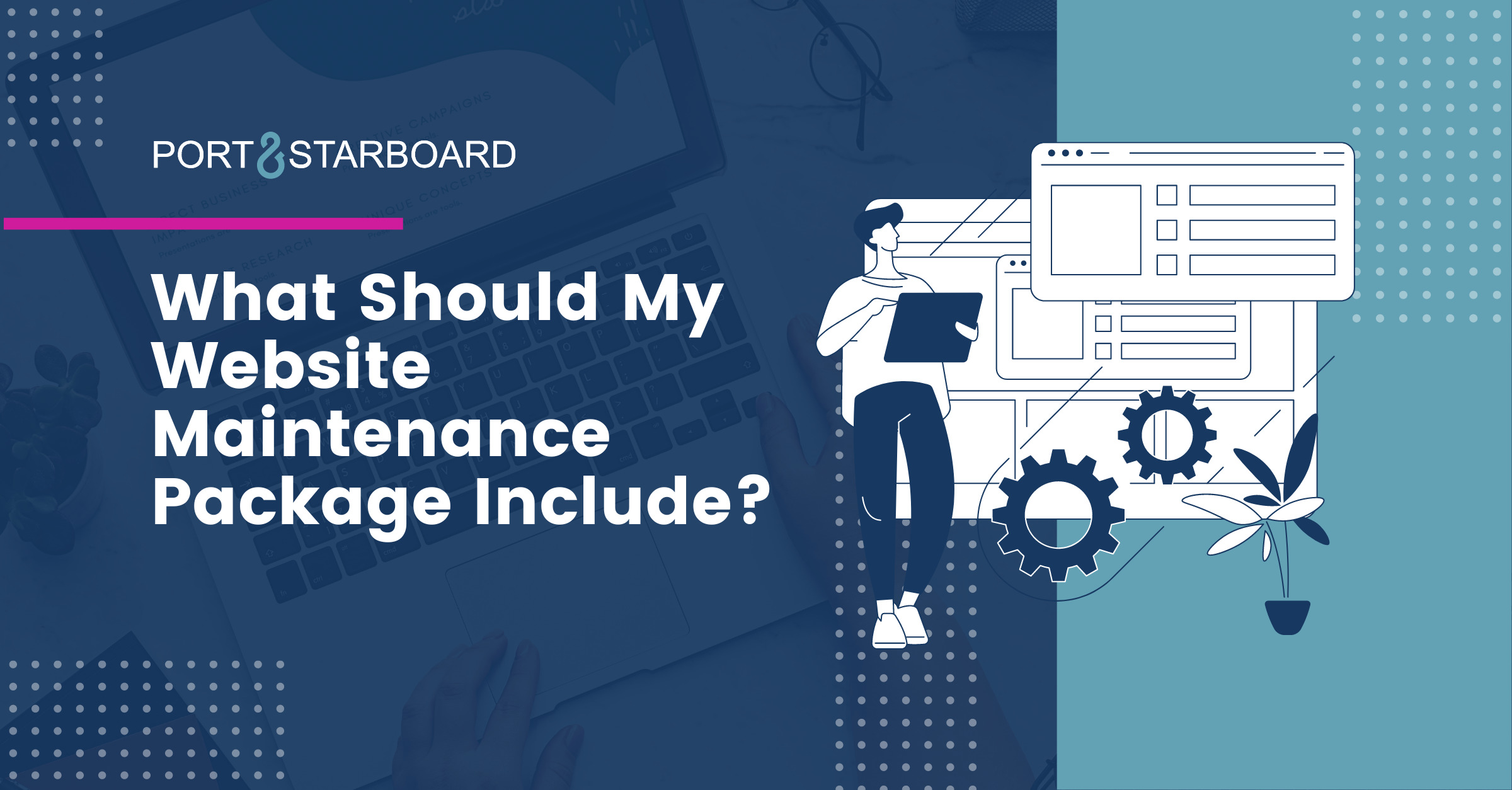In today’s connected world, your business website is part of the foundation of your organization. The easier you are to find on search engines, the more business leads you’ll have. Your website allows prospects to learn more about and connect with your business. It can also act as your 24/7 salesperson.
Building an eye-catching and top-performing website is a good start, but technology doesn’t drop anchor and stay in one place. Adopting a website maintenance plan is like charting a course for a successful journey. Ongoing maintenance is critical for keeping customer data safe and your business sailing smoothly.
What is effective website maintenance?
Effective website maintenance involves continually monitoring your website to ensure optimal performance, safety, and health. It’s best to establish a regular schedule for necessary maintenance tasks. Some of these should be completed daily or weekly, while others are recommended on a monthly, quarterly, or yearly basis.
Continual monitoring, setting up a maintenance schedule, and promptly performing the right tasks can overwhelm the in-house resources of many companies. One way to ensure they are completed on time and correctly is to partner with a trustworthy website company.
Hiring a team that knows how to keep your website updated, secure, and operating at total capacity lets you focus on steering the ship of your business. Your website management partner can quickly identify any issues and fix them before you fall off course (losing precious time and money).
Why are website maintenance packages necessary?
Skipping critical maintenance tasks can compromise your website’s security, reliability, and overall functionality. Maintaining good digital hygiene can help protect your customers’ data, improve their interactions with your company, and increase your business’s trustworthiness and goodwill. Up-to-date website maintenance can also boost your site’s visibility and authority on search engines, increasing your website’s chances of rising to the top of search results.
A website maintenance package can reduce your overall costs by ensuring that the recommended preventative maintenance tasks happen as scheduled. An effective website maintenance package can prevent many issues, including embarrassing and expensive data security breaches. Waiting until a catastrophic event occurs can be costly, not only in terms of monetary costs but also in the loss of significant goodwill and public trust in your business.
What does a website maintenance package include?
Competent web companies may offer various packages, including website management and hosting. Generally, web maintenance packages should include some combination of the following features.
1. Backups
Regular backups are vital for all digital components of your business. A web maintenance service should perform backups at least weekly for your website. For some clients, daily backups may be appropriate. Backups can be easily automated to the cloud, and backup copies can be saved to external media for extra protection (if desired).
2. Updates
Many website platforms, like WordPress, allow you to customize a website using themes, software, and plugins. If these components aren’t set to update automatically, your maintenance service should do a weekly check-in to update them manually. Outdated plugins can significantly slow down a site’s load speeds or cause page elements to freeze or glitch, so it’s vital to ensure they are updated regularly.
However, the update process doesn’t always go seamlessly. For example, theme updates can cause graphic elements to render incorrectly or shift on a page. A skilled web maintenance team can check in periodically to ensure updates are installed correctly and operating as intended.
3. Monitoring
A crucial part of keeping your website healthy is regular monitoring. Here’s an overview of the tasks your website partner may perform weekly, quarterly, and once a year.
Weekly
During this check, your maintenance partner should perform the following tasks:
- Make sure all pages on your site load properly (quickly and without error).
- Identify and resolve any 404 errors and broken links
- Check for any comments, form submissions, or other communications from users that have not been addressed.
Quarterly
Your maintenance partner should also do a quarterly check-up to identify new opportunities to improve your site’s performance. This may involve optimizing visuals to load faster, deleting unnecessary files to increase overall site speed, and automating manual, repetitive tasks to speed up processes and workflows.
Annually
It’s also a good idea to conduct a yearly audit of all content on a site, including written content, graphics, images, videos, and other visual elements, to ensure they’re still relevant. You may need to swap some visuals out to stay on-trend. Do a complete review for errors, typos, and outdated information.
4. Testing
Periodically, you should perform additional tests to evaluate your site’s performance. At least monthly, test how fast your website loads on different devices and browsers. Ideally, landing pages should take no longer than two or three seconds to load.
A more comprehensive test should be performed once a year after you’ve made necessary updates and performance fixes. Based on the test’s results, you can update any outdated information, analyze all features to ensure optimal performance, and take any additional steps necessary to keep your website running smoothly.
5. Security
Cybercrimes have risen 600% due to the COVID-19 pandemic, nearly half of which are web-based. But 70% of small businesses aren’t prepared to deal with denial-of-service (DoS) attacks, data security breaches, or other cyber-attacks. Your website maintenance team must be able to keep up with the latest threats and know how to prevent or fix vulnerabilities in your system.
Comprehensive virus and malware-removal software, critical updates, and vulnerability patches are crucial components of preventing cyber-attacks. Scans should take place at least daily. For highly vulnerable businesses, more frequent scans may be prudent. Scans can detect potential issues early and address them before they cause problems for your company.
In addition to threats, web maintenance professionals should also regularly monitor for and delete “spam” comments. These include irrelevant content, outside sales and solicitations, and inappropriate or violent content.
6. Analytics
A website maintenance team should check Google Analytics and other performance tools to review key metrics (KPIs) and track your site’s performance over time. Website visits, conversions, and bounce rates can help pinpoint specific areas for improvement. Your website partner should share analytics reports with you at least monthly. These results can help you determine the changes you should implement to improve your site’s performance.
If you regularly add new pages to your website, such as blog posts or announcements, also analyze your content’s performance monthly to see if you should refresh or optimize anything to perform better. Compare your website performance metrics with your defined goals to ensure they align. At least once a year, check your top-performing content pages and determine if you can optimize them further or repurpose them to increase their reach. Consider taking down outdated content and publishing new content to address its target audience.
7. Support
Every year, website hosting and maintenance packages should help you review and renew your domain name, hosting service, and additional tools (like keyword research platforms, paid ad services, etc.).
A top-notch website team will support not only the technical performance of your website but your overall website presence. They can help you review your marketing and advertising campaigns for effectiveness and make changes as needed.
If your site isn’t supporting your current marketing strategies, you may need to update your website. You should evaluate this annually to see if you can make minor tweaks to the design and technology to give it a fresh look and attract new users. If it’s starting to get outdated, consider a website redesign (typically required every 2-3 years).
8. Functionality
Finally, website maintenance packages should include at least a monthly inspection to ensure your site is performing how you want it to. This means checking all forms, calls to action (CTAs), popups, and checkout processes to ensure they’re secure and working correctly.
How much do web maintenance packages cost?
The cost of website maintenance packages varies depending on the size and complexity of your site. The time requirement and cost of maintaining a small personal website are generally much lower than for a large corporate or e-commerce site. However, some small sites can have functionalities (or vulnerabilities) that require more hands-on work to maintain.
In general, cost estimates tend to fall in the following ranges:
- Small personal website: Up to $50 per month (only domain name + hosting services)
- Small business website: Up to $200 per month (previously listed services + marketing, updates, content, and design)
- Medium e-commerce website: Up to $2,500 per month (previously listed services + customized coding and customer data)
- Large corporate website: Up to $3,500 per month (previously listed services + subscriptions, secure online payments, customer account portal)
Most website maintenance packages are customized to suit the needs of each client.
All-Inclusive Website Hosting and Maintenance Packages
- Hosting
- Redundant backup of site and data
- Regular installation of WordPress and plugin updates
- Self-service access to update site data and content
- Optimized site performance through the use of a content delivery network (CDN)
- Monthly health check and analytics reports delivered via email
- Site design changes
- Data conversion/data migration
- Content posting (e.g., portfolio or blog entries)
- Training for updating site data and content
- Google Analytics technical support
- Integration with other business applications
Contact us to learn more about web design, hosting, maintenance, or related services. We look forward to hearing from you!




